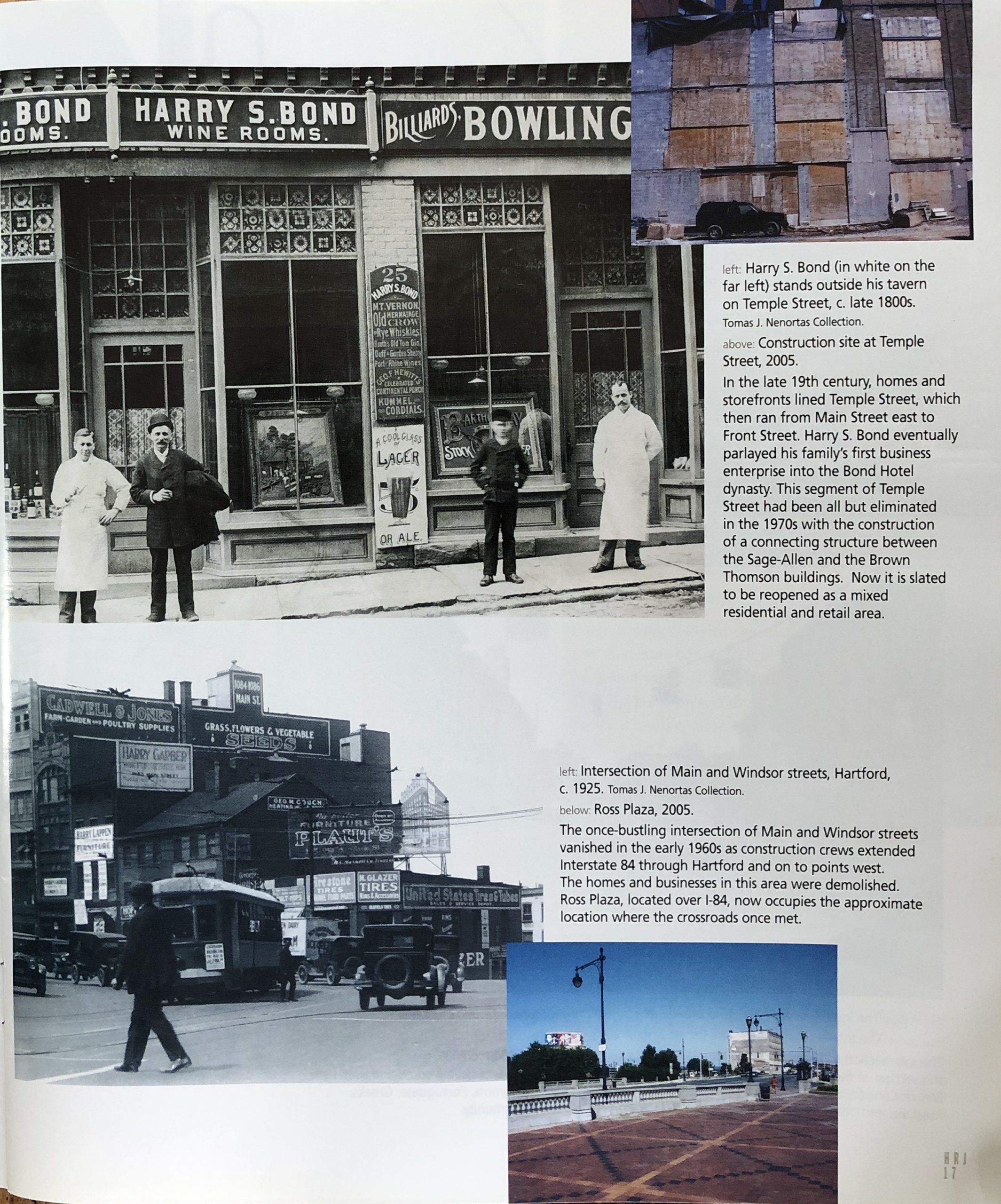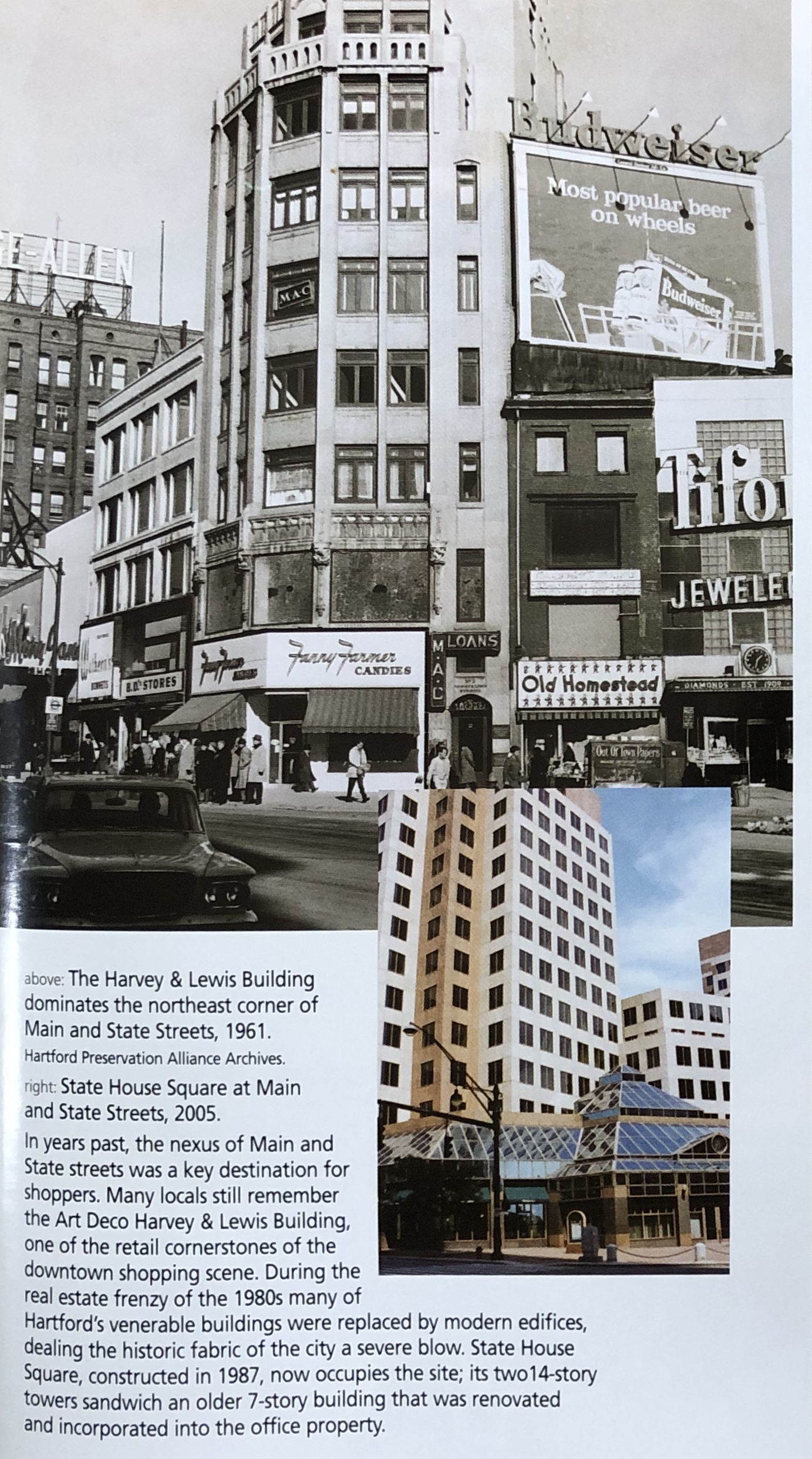
top right: Gold Street with a view of the Wadsworth Atheneum Museum of Art, Main Street, 2005. photo: Karen O’Maxfield, Studio O’Maxfield, Hartford. left: Gold Street, off of Main Street, was once an extremely narrow passage. This undated 19th-century image is one of the earliest known photographs of Hartford’s African-American residents.
By Nancy O. Albert, Tomas J. Nenortas, and Karen O’Maxfield
(c) Connecticut Explored Inc. Winter 2005/2006
Subscribe/Buy the Issue!
As the structures that define a city like Hartford rise and fall, or weather the tests of time, our sense of place evolves. Connecticut’s public and private archives are rich with photographs of Hartford at various times in its past. HRJ’s photo editor Nancy Albert asked Tomas J. Nenortas and Karen O’Maxfield to help document this evolution in pictures.
Nenortas, president of the Hartford Preservation Alliance and collector of historic Hartford images, many of which were recently published in his Victorian Hartford (Arcadia Publishing, 2005), identified the locations depicted in historic images and supplied details about the transformations that have taken place. O’Maxfield, a professional photographer, Hartford native, and preservation activist, then ventured to the sites to capture the contemporary scene from the same vantage point. This required ingenuity and, in some cases, where quiet spots have become busy thoroughfares, more than a little daring.
top of page: Vendors’ pushcarts lined up along Front Street, 1935. Hartford Collection, Hartford Public Library. inset right: Constitution Plaza, 2005. Front Street, located on Hartford’s east side near the Connecticut River, was the first address for many of the city’s newly arrived immigrants. In a move that remains controversial, the entire polyglot neighborhood was leveled in the 1960s and its residents displaced to other parts of the city to make way for Constitution Plaza and its accompanying office buildings. Many argue that the project failed to produce the desired revitalization of the area. Now, with the recent connection of Constitution Plaza to the newer Riverfront Plaza, this public space is proving more enticing to Hartford’s residents, workers and visitors. lower left: The Charles Edward Prior family on the porch of their home on North Beacon Street. Private mailing card, 1906. Tomas J. Nenortas Collection. to its right: Current owners Robert and Dorothy Stavinsky, 2005. This Queen Anne-Classical Revival house on North Beacon Street was built in 1900 for Albert Scoville, a local builder and architect. The porch has since been enclosed, and the once twiggy sapling out front now towers above the roof.

top left: Harry S. Bond (in white on the far left) stands outside his tavern on Temple Street, c. late 1800s. Tomas J. Nenortas Collection. top right: Construction site at Temple Street, 2005. In the late 19th century, homes and storefronts lined Temple Street, which then ran from Main Street east to Front Street. Harry S. Bond eventually parlayed his family’s first business enterprise into the Bond Hotel dynasty. This segment of Temple Street had been all but eliminated in the 1970s with the construction of a connecting structure between the Sage-Allen and The Brown Thomson buildings. Now it is slated to be reopened as a mixed residential and retail area. bottom left: Intersection of Main and Windsor Streets, Hartford, c. 1925. Tomas J. Nenortas Collection. bottom right: Ross Plaza, 2005. The once-bustling intersection of Main and WIndsor Streets vanished in the early 1960s as construction crews extended Interstate 84 through Hartford and on to points west. The homes and businesses in this area were demolished. Ross Plaza, located over I-84, now occupies the approximate location where the crossroads once met.

top of page: The intersection of Park and Broad Streets, 1948. Hartford Collection, Hartford Public Library. bottom: The intersection of Park and Broad Streets, 2005. The intersection of Park and Broad streets appears little changed from 1948 to 2005, though this section of the city has evolved as many generations of Hartford residents have worked and lived here. French Canadians settled here in the early 1800s, followed by Irish immigrants, Portuguese, Greeks, Russians, and others. Today, the area is a hub for Hartford’s Hispanic community.
top: The Harvey and Lewis Building dominates the northeast corner of Main and State Streets, 1961. Hartford Preservation Alliance Archives. bottom right: State House Square at Main and State Streets, 2005. In years past, the nexus of Main and State streets was a key destination for shoppers. Many locals still remember the Art Deco Harvey and Lewis Building, one of the retail cornerstones of the downtown shopping scene. During the real estate frenzy of the 1980s many of Hartford’s venerable buildings were replaced by modern edifices, dealing the historic fabric of the city a severe blow. State House Square, constructed in 1987, now occupies the site; its two 14-story towers sandwich an older 7-story building that was renovated and incorporated into the office property.
A Message from the Hartford Preservation Alliance
By Laura Knott-Twine
As I look at these photographs of Hartford past and present, I’m reminded of the two clear pictures I carry in my memory of the East Hartford street where I lived as a child. In one I’m walking home from school on a winter afternoon. Snow outlines every roofline, and each chimney is capped with a frozen hat. This may have been the first time I appreciated the look of where I lived. In the other scene two back-to-back hurricanes have turned the streets into rivers, and rowboats make their way past our front door; the year is 1955.
It is not just childhood memories that should be cherished; the very buildings and streetscapes that populate those memories should be valued and protected, too. Venerable facades, simple storefronts, grand homes, and ordinary houses shed light, so to speak, on the people who built them. They also give us insight into those who live and work there today. Preservation goes beyond nostalgia; it goes to the heart of our individual and collective identities.
If our buildings, shared experiences across generations, and memories help to define who we are, we should be careful what we tear down and what we build up. The Hartford Preservation Alliance’s mission is to preserve and revitalize Hartford’s unique architectural heritage and neighborhood characteristics. Preservation-minded decisions include such things as rehabilitating an old factory to house small businesses, planting new trees, restoring the facades of old buildings, and building new structures that complement a neighborhood’s existing flavor.
Preservation does not mean that every brick and board should stay in place. Rather, it required that we evaluate proposed changes and intervene, when needed, to save the best of our heritage.
Laura Knott-Twine is executive director of the Hartford Preservation Alliance. To learn more about the HPA’s activities call (860) 570-0331 or visit www.hartfordpreservation.org.
Explore!
More stories about historic preservation under Topics, then find our listing for Historic Preservation.


